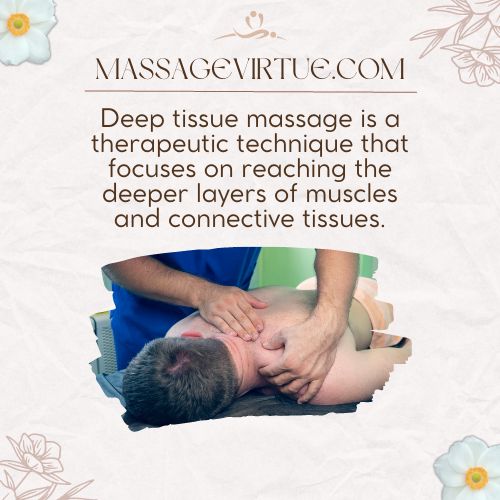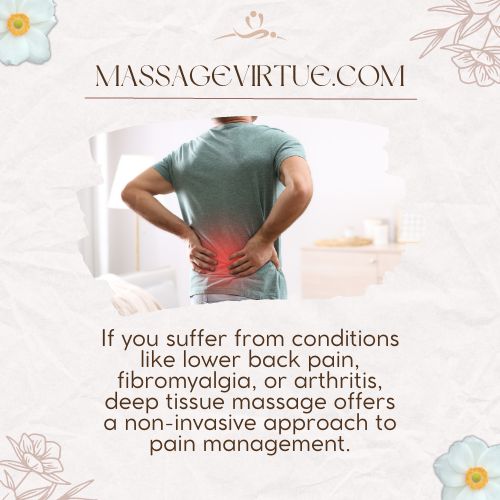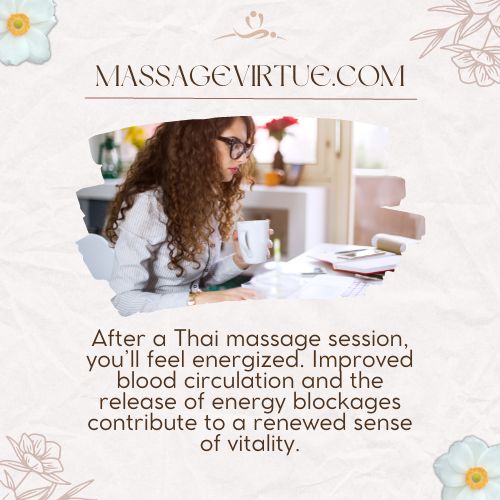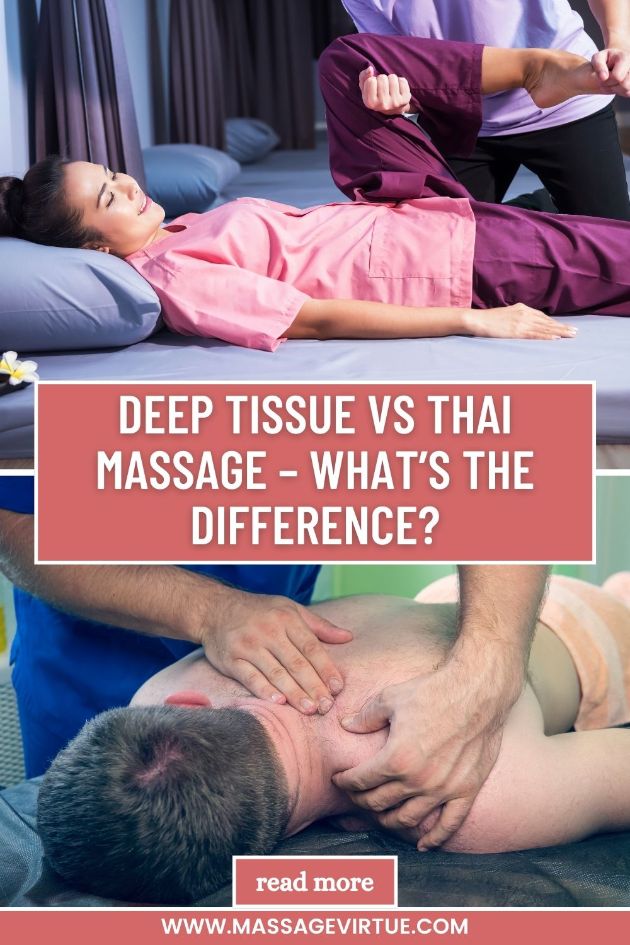If you’re considering getting a massage to relieve muscle tension or chronic pain, or simply to unwind and relax, you’ve likely come across two popular options: deep tissue massage and Thai massage.
Both offer unique benefits and choosing the right one for your needs can make a significant difference in your overall massage experience.
In this article, we’ll provide a detailed comparison of deep tissue vs. Thai massage, highlighting their key differences, benefits, and potential side effects.
Deep Tissue Vs Thai Massage – Comparison
| Feature | Deep Tissue Massage | Thai Massage |
| Areas | Deep muscle layers | Entire body |
| Technique | Deep pressure, kneading, circular strokes | Stretching, compression, pressure points |
| Oils/Lotions | Often used | Not typically used |
| Clothing | Disrobed, with draping | Clothed, comfortable attire |
| Pain Level | Can be intense | Moderate to mild |
| Duration | Typically 60-90 minutes | 90 minutes to 2 hours |
| Focus | Muscle tension and pain relief | Relaxation and flexibility |
| Energy Flow | Limited emphasis | Focus on energy lines and flow |
| Suitable For | Specific muscle issues, chronic pain | General relaxation, flexibility |
What is a Deep Tissue Massage?
Deep tissue massage is a therapeutic technique that focuses on reaching the deeper layers of muscles and connective tissues.

It’s particularly beneficial for individuals dealing with muscle stiffness, knotted muscles, chronic pain, or sports injuries.
This type of massage uses various techniques.
These include deep pressure, kneading, and circular strokes, to alleviate tension and improve muscle flexibility.
Deep Tissue Massage Benefits
Deep tissue massage is a highly effective therapeutic technique known for its ability to relieve various physical discomforts. Let’s explore three key advantages:
1. Muscle Tension Relief
Deep tissue massage targets and releases muscle tension and tight knots deep within your muscle and connective tissues.
This precise technique, delivered with firm pressure, provides you with immediate relief from stiffness and soreness.
2. Chronic Pain Management
If you suffer from conditions like lower back pain, fibromyalgia, or arthritis, deep tissue massage offers a non-invasive approach to pain management.

It reduces inflammation and promotes blood circulation, aiding in the relief of chronic pain.
3. Improved Flexibility
Athletes and active individuals benefit from deep tissue massage’s ability to release tension and elongate muscle fibers.
This promotes enhanced flexibility and range of motion, reducing the risk of injuries and improving your physical performance.
Is Deep Tissue Massage Painful?
Deep tissue massage can be intense, and some people may experience discomfort during the session, especially if they have a low pain tolerance or highly sensitive muscles.
However, communication with your massage therapist is key.
They can adjust the pressure to ensure your comfort while still providing the desired therapeutic benefits.
What is Thai Massage?
Thai massage, also known as Thai yoga massage, is a traditional healing technique that originated in Thailand.
It involves a combination of stretching, compression, and pressure along energy lines and points in the body. Unlike deep tissue massage, Thai massage is typically performed fully clothed and without the use of oils or lotions.
Thai Massage Benefits
Thai massage, rooted in Thai tradition, provides numerous advantages that extend beyond relaxation. Here are three key benefits:
1. Improved Flexibility
Thai massage excels your enhancing joint flexibility and muscle mobility.
Assisted stretches and gentle pressures target muscles and joints, making it ideal for those with a limited range of motion.
2. Energy Boost
After a Thai massage session, you’ll feel rejuvenated and energized.

Improved blood circulation and the release of energy blockages contribute to a renewed sense of vitality.
3. Deep Relaxation
Thai massage not only relieves physical tension but also offers profound relaxation and stress reduction. Rhythmic movements and pressure points create tranquility and mental clarity.
It provides a respite from the stresses of daily life.
Is Thai Massage Painful?
Thai massage is generally less intense than deep tissue massage, but it can still be somewhat uncomfortable, especially during stretches and deep compressions.
The level of discomfort largely depends on your body’s flexibility and your individual tolerance.
Communicating with your Thai massage therapist about your comfort levels is essential to ensure a positive experience.
Deep Tissue Vs Thai Massage – Side Effects
| Side Effect | Deep Tissue Massage | Thai Massage |
| Soreness | Possible, especially after the first session | Mild soreness |
| Bruising | Occasional, if excessive pressure is applied | Rare |
| Fatigue | Common, due to the intensity | Possible, due to stretching |
| Muscle Pain | Temporary discomfort | Rare |
| Allergic Reactions | Rare | Rare |
| Headaches | Occasional, if dehydration occurs | Rare |
Which Massage Is Good For You?
If you’re dealing with muscle knots and tension, go for deep tissue massage. It’s like a deep, targeted massage that relieves tight spots and helps with chronic pain.
On the other hand, if you want to feel more flexible and relaxed overall, Thai massage is great. It involves stretching and can boost your energy while providing a deep sense of relaxation.
Conclusion
In summary, both deep tissue and Thai massage offer unique benefits.
The choice between them largely depends on your specific needs and preferences. If you’re dealing with specific muscle issues or chronic pain, deep-tissue massage may be the better choice.
On the other hand, if you’re looking for overall relaxation, improved flexibility, and a holistic approach, Thai massage could be the ideal option.
Remember that individual experiences may vary, and it’s essential to communicate openly with your massage therapist to ensure a comfortable and effective session.
FAQs
Is Deep Tissue Massage the Same as Thai Massage?
No, they are different. Deep tissue massage targets deep muscle layers using pressure and kneading, while Thai massage incorporates stretching, compression, and energy flow along with assisted movements.
Does Thai Massage Get Rid of Knots?
Yes, Thai massage can alleviate knots and muscle tension by using stretches and compressions to release tightness within muscles.
What Makes Thai Massage Different?
Thai massage is unique due to its emphasis on assisted stretching, energy flow, fully clothed sessions, and its holistic approach to body-mind-spirit balance.
Is Thai Deep Tissue Massage Good for You?
Thai deep tissue massage combines deep muscular work with Thai massage techniques.
It can be beneficial if you prefer a blend of deep pressure and stretching to relieve muscle tension and improve flexibility. Discuss your preferences with your therapist for a personalized session.


